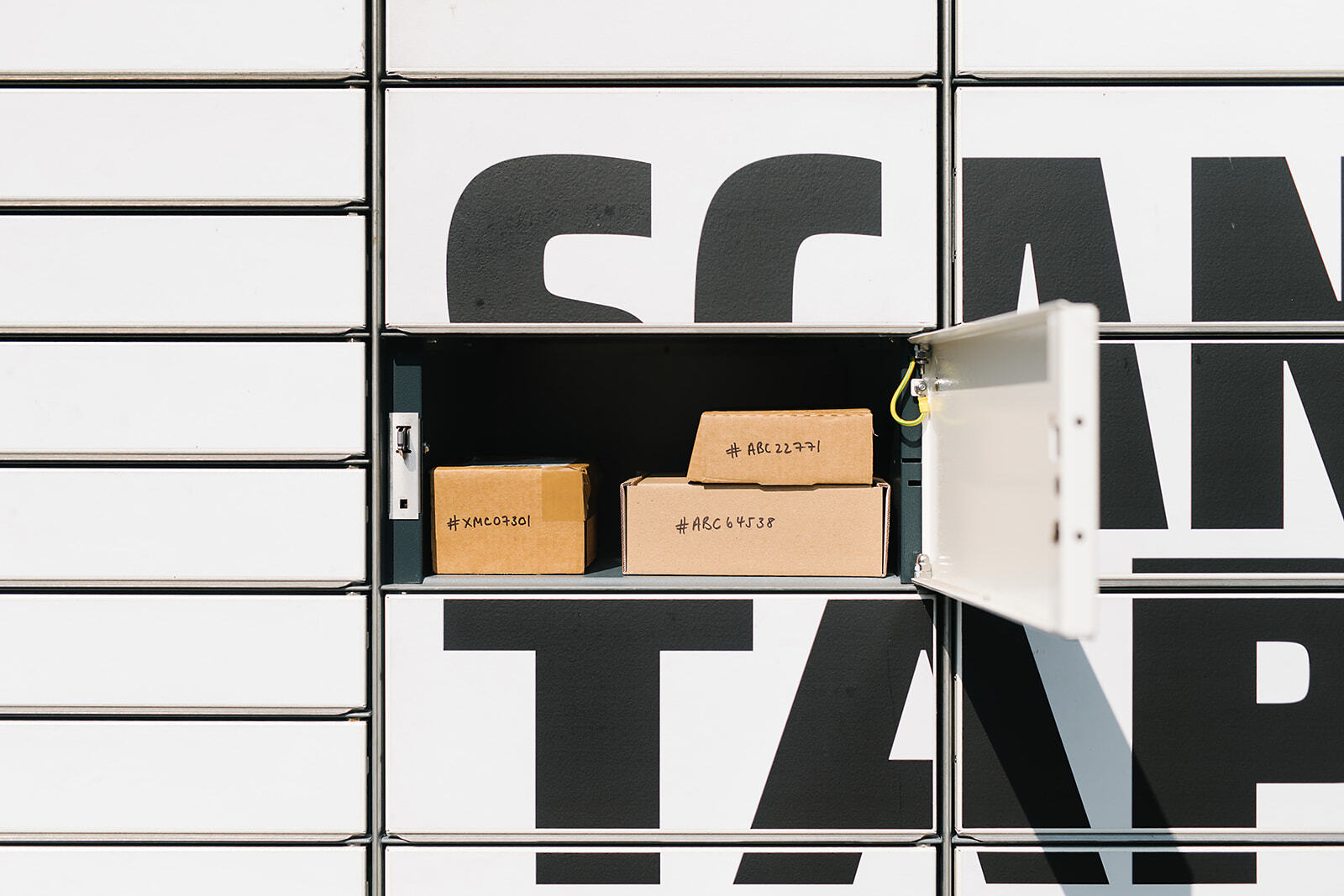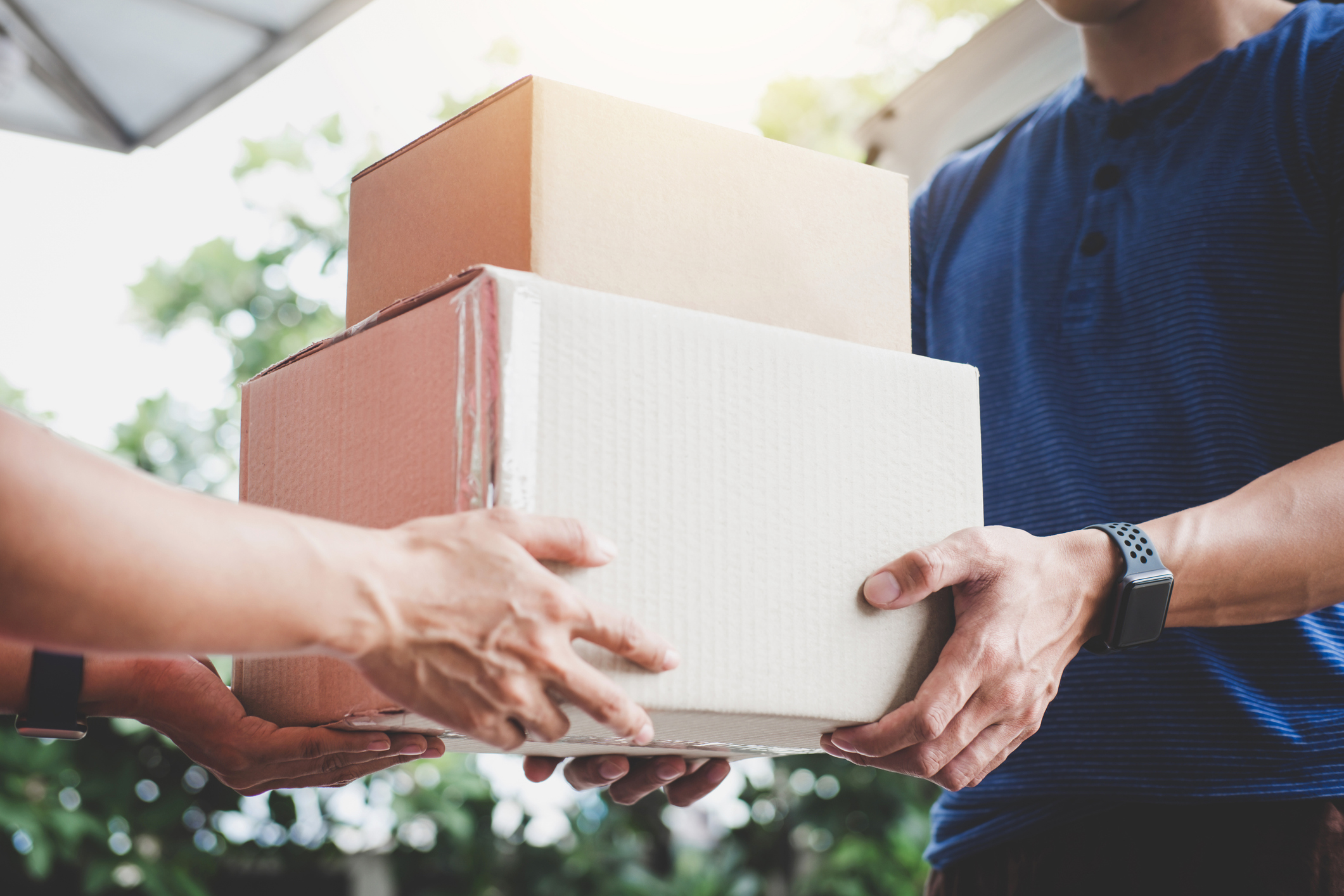At stampfree.ai, we believe the next wave of locker innovation must go beyond simply expanding networks. Below are five promising future directions for lockers in the UK and Europe – and how our patented, AI-powered labelfree multi-consignment solution fits into that trajectory.
Mobile Locker Robots and Drone-Compatible Drop Zones
Static lockers are powerful, but they do not reach every street, suburb or rural lane. In 2024, DPD in the UK began deploying locker-equipped autonomous robots (“Ottobot”) capable of navigating streets and serving multiple customers in one run (SCW, 2024).
These mobile lockers act like mini depots on wheels: they travel, stop near customers, open compartments, and collect or drop parcels.
In parallel, drone-to-locker pilots in Europe are being tested, where aerial drones deposit packages in specially designed locker bins or rooftops. These mobile and aerial integrations suggest a future where locker infrastructure is dynamic, not fixed – enabling more last-mile flexibility in underserved zones.
Lockers as Everyday Commerce Portals
Lockers are not only for shipping and returns – they are poised to become omnichannel retail and service portals in local communities. At the DELIVER Europe 2025 conference, Geopost highlighted how out-of-home (OOH) delivery is now hybrid: lockers, parcel shops, and click-and-collect all work together (Geopost, 2025).
The latest E-shopper Barometer shows that parcel lockers have overtaken parcel shops to become the second most popular delivery method after home delivery, with the shift strongly driven by Gen Z. This group makes over 60 online purchases a year – more than any other generation – and places a premium on flexibility and convenience. They also blur the lines between retail and social platforms: 96% use social media for inspiration, 61% buy directly on those platforms, and 72% of all regular e-shoppers now use C2C marketplaces. Trust in carriers is also rising, with 76% of shoppers caring about who delivers their order.
The UK picture confirms this momentum. Research shows 40% of UK adults used a parcel locker in 2024 – about 21 million people – with usage even higher among younger groups: 66% of Gen Z and 54% of Millennials (InPost UK, 2024). More than half of under-45s now use lockers monthly, indicating that lockers are shifting from trial to routine. Once people try lockers, they tend to double their frequency of use compared to the wider base, embedding them as part of daily shopping.
Low-Friction Returns and Peer-to-Peer Transactions
Returns remain one of e-commerce’s major pain points. According to DHL eCommerce’s 2025 Out-of-Home Delivery & Returns Trends, 79% of European shoppers return unwanted items via parcel lockers or parcel shops (DHL, 2025). Consumers increasingly expect to scan a QR or input a code at a locker and drop off the package – a frictionless experience that shifts returns from an operational burden into a seamless part of the shopping journey.
Lockers are also becoming the infrastructure for peer-to-peer (C2C) trade. Platforms such as Vinted are fuelling a surge in second-hand commerce, with surveys showing three in four locker users have already used them for C2C transactions (InPost UK, 2024). For this growing market, lockers offer secure, contact-free exchanges at scale – and the demand for labelfree, intuitive sending is only rising.
stampfree.ai’s Patented AI-Powered Labelfree Multi-Parcel Model
At stampfree.ai we believe the next true breakthrough is in labelfree multi-parcel drop-offs powered by our patented AI handwriting recognition. Consumer research shows the challenge with current labelless systems: 32% of people are uncomfortable leaving parcels with no visible shipping ID, while 26% will not do so at all. In total, 62% of consumers are unwilling or uneasy about existing labelless approaches. This is a structural trust gap that limits adoption.
Behavioural data also shows strong demand for more flexible sending. 26% of consumers already use lockers to send parcels, with 13% doing so weekly. A smaller group of 7% send 2–3 parcels at a time weekly, and that 7% alone accounts for around 40% of locker space usage. Yet most locker systems today only permit one parcel per slot, meaning heavy senders are under-served and valuable space is wasted.
Our patented, AI-powered labelfree solution changes this. With stampfree.ai, senders generate a unique code via browser, app or WhatsApp, write it on the parcel, and validate it using their phone camera. Our AI instantly checks the handwritten code, tethering all tracking information to it before the parcel even leaves the sender. At the locker, the customer scans once, opens a compartment, and can deposit several parcels together, each visibly bearing its own validated identifier. When the carrier collects, our system scans the codes, retrieves the data, and if required prints barcoded labels downstream.
For consumers, this restores the visible trust signal of a shipping ID while keeping the process printer-free, simple and digital. For carriers, it reduces handling costs per parcel, enables same-day home collections without labels, and avoids locker printer maintenance entirely. For locker operators, it increases throughput and maximises ROI by enabling multiple consignments per unit.
In short: Parcel, Pen & Phone. Our patented AI-powered validation makes labelfree shipping secure and scalable, simplifying parcel handling, removing printer challenges, and boosting efficiency across lockers, PUDOs and delivery networks.
Open Networks and Interoperability
The next major frontier is not just adding more lockers, but making them open and carrier-agnostic. Today, Europe’s locker landscape is fragmented: DHL, InPost, Amazon and others operate closed networks, forcing customers to juggle multiple apps and locations. This creates inefficiency for carriers and confusion for consumers.
In response, pioneers such as DeinFach in Germany are launching open locker networks that allow multiple carriers to share the same infrastructure (Bloq.it, 2025). Supported by technology partners like Bloq.it, these networks are built on interoperable, vendor-neutral protocols. Features such as self-healing locker systems and IoT-grade security ensure resilience and trust.
For cities and retailers, open networks reduce delivery congestion, cut costs, and increase foot traffic. For consumers, they mean true convenience: one interface, one network, all carriers. For carriers, it’s a way to consolidate last-mile costs while still competing on service.
At stampfree.ai, we see open networks as the ideal environment for our multi-consignment solution. If lockers are to be shared, utilisation and trust become even more critical – and our approach is designed precisely to maximise both.
Smart Siting and Occupancy
Even as networks expand, not every locker will succeed. With European parcel volumes projected to climb from 17 billion in 2022 to 30 billion by 2028, some analysts forecast that up to 80% of parcels could flow through lockers by 2030 (McKinsey, 2024). But profitability depends on more than scale. Lockers require 30–50% occupancy to break even, with typical installation costs of €20,000–40,000 and payback periods of 12–24 months (Supply Chain Brain, 2025).
This is where Location Intelligence comes in. By analysing demographics, purchasing power, mobility flows, and points of interest, operators can site lockers where they will achieve sustained usage. Case studies such as Dr. Max’s partnership with CleverMaps show how pharmacy chains are using data to ensure lockers land in high-demand zones.
For the future, this means the winning lockers will be both smartly placed and fully utilised. Location Intelligence ensures they are in the right spots; stampfree.ai ensures they are used to their full capacity. Together, that combination will determine whether lockers deliver not just convenience but also sustainable returns.
The Trajectory Ahead
Locker adoption across Europe is uneven. Poland already has over 1 locker per 1,000 inhabitants, while the UK sits at just 0.23 and Germany at 0.18 (Kearney, 2024). Mature markets could reach 2 per 1,000 people by 2032, meaning penetration in much of Western Europe still lags well behind potential.
This fuels the chicken-and-egg dilemma: low density limits consumer adoption, but without adoption networks struggle to justify further investment. InPost succeeded by prioritising consumer experience with a user-friendly app and strong merchant partnerships. We see the same principle applying more broadly: great UX is what drives utilisation. That is precisely where stampfree.ai adds value: by enabling trusted, visible, multi-consignment drop-offs, we help boost throughput and consumer confidence early, breaking the adoption cycle and making locker investment pay back faster.
Analysts forecast 11–12% annual growth in parcel locker deployments through at least 2027, with the broader OOH market projected to grow around 15% per year to 2030 (Cross-Border Magazine, 2025). The more lockers appear, the more shoppers expect them, and the more carriers must adapt. For retailers and carriers alike, the priority is no longer simply “whether to invest” but how to make each locker work harder. We at stampfree.ai believe our solution is one of the levers that can make this future not just larger in scale, but smarter and more sustainable.




